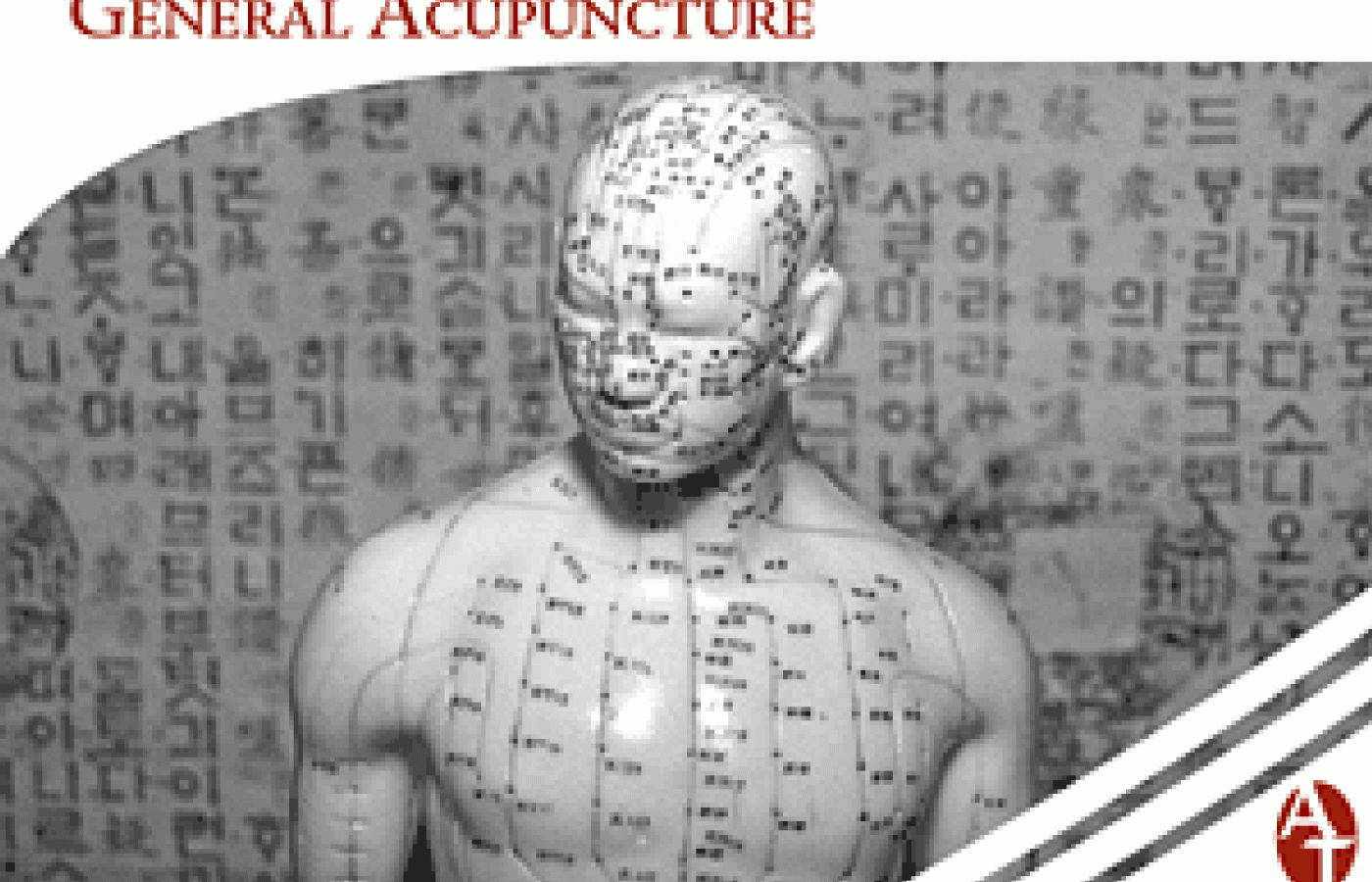Whether you accept it, avoid it or live somewhere in between, insurance coverage has become a defining issue for our profession. Patients increasingly expect to use their benefits, practitioners want to be compensated fairly for their time and expertise, and the system itself remains – at best – fragmented. The encouraging news is that coverage has expanded in meaningful ways. The challenging news is that reimbursement, across the board, remains inadequate.
Pain Relief Acupuncture Using the Minor Chakra Acupoints
Acupuncturists spend more time trying to ease a patient's pain than anything else. We may use a variety of methods ranging from traditional Chinese acupuncture to symptomatic modern Western "pin pricking" to achieve our goals. In each and every case of pain relief, however, it is the symptoms of pain and discomfort that are addressed and not the cause. A typical scenario is that we spend a couple of sessions using local/distal acupuncture to ease discomfort followed by several more to try and address the etiology. I have devised a method whereby the pain and the etiology may be treated at the same time.
The Minor Chakras
Minor Chakras are energetically powerful acupoints that are "reflected points" of the seven major chakras having similar properties to their more illustrious counterparts. They are, though, much easier to use with acupuncture than the Majors. Traditionally there are 21 Minor Chakras although the Spleen chakra is not used in pain relief. I have always maintained that a high percentage of medical (and even musculo-skeletal) conditions are caused by emotional imbalance. If the chakra energies are balanced and treated correctly, the origin of the illness is addressed as each of the acupoints is linked with various emotional, endocrine and autonomic nerve imbalances. I am utterly convinced that by just treating the pain syndrome and ignoring the underlying cause, a great injustice is being done to the patient.
The 20 minor chakra acupoints described are generally found on the periphery of the body. They are as follows:
Foot chakra - KI 1
Hand chakra - PC 8
Knee chakra - BL 40
Elbow chakra - PC 3
Groin chakra - ST 30
Clavicular chakra - KI 27
Shoulder chakra - LI 15
Navel chakra - KI 16
Ear chakra - TE 17
Intercostal chakra -SP 21
For the purposes of pain relief they may be coupled together as follows:
- Hand and Foot which are linked with the CROWN chakra
- Elbow and Knee which are linked with the BASE chakra
- Groin and Clavicular which are linked with the BROW chakra
- Shoulder and Navel which are linked with the THROAT chakra
- Ear and Intercostal which are linked with the HEART chakra
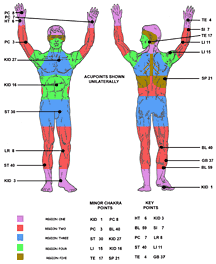
Key Points
When starting my investigation into this field of research, I soon realized that it wasn't just a question of needling the Minor Chakras to affect pain relief. I needed something else to accompany these points. I took my cue from studying the eight extraordinary meridians with their associated key points that "open up" the channel. I discovered that each of the Minor Chakras has its own dedicated Key point that is used to facilitate and enhance the treatment in a similar way to that of the extraordinary meridians. The Key points have no obvious logical anatomical positions and just have to be learnt.
Regions
For the purposes of using the Minor Chakras in pain relief, the body is divided into five different areas that are associated with a set of coupled Minor Chakras – each called a Region. To use each Region you need to know the following:
- The acupoint of the Minor Chakra
- The acupoint of its Key point
- The acupoint of the coupled Minor Chakra
- The acupoint of its Key point
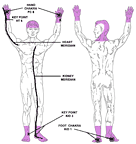
Region One |
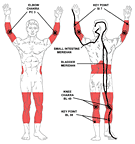
Region Two |
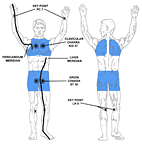
Region Three |

Region Four |

Region Five |
Hand chakra – PC 8
Key point – KI 3
Foot chakra – KI 1
Key point – HT 6
Region Two – Elbow and Knee chakras
Elbow chakra – PC 3
Key point – BL 59
Knee chakra – BL 40
Key point – SI 7
Region Three – Groin and Clavicular chakras
Groin chakra – ST 30
Key point – PC 7
Clavicular chakra – KI 27
Key point – LR 8
Region Four – Shoulder and Navel chakras
Shoulder chakra – LI 15
Key point - ST 40
Navel chakra – KI 16
Key point LI 11
Region Five – Ear and Intercostal chakras
Ear chakra – TE 17
Key point – TE 4
Intercostal chakra – SP 21
Key point – GB 37
The illustration shows each Region with the areas of pain relief dedicated to each one.
Technique
- You need to find where the pain is – it could be muscular, joint, sensory, sympathetic or spinal referred pain that affects the dermatome or nerve.
- When you have decided on the pain area to be treated, both Key points are needled and stimulated (tonified) for a few seconds and the needles left in situ. It is very important that the Key points are tonified for a few seconds every five minutes or so. It is also imperative that the patient experiences the de qui sensation.
- Once the Key points have been stimulated for the first time, needle both minor chakra points. Stimulate the needle just enough to experience de qui but no longer than that. These needles remain untouched for the remainder of the treatment session.
- When an overlap of the pain area occurs (very common), the second Region may be treated at the same time – making eight needles in all. Do not attempt to treat more than two Regions at one time. With complex cases that exhibit more than two pain areas, start with the one that has the most acute presenting symptoms.
- Electro acupuncture may be used to keep the Key points stimulated but on no account should it be used with the minor chakra points.
- This should be a "stand alone" treatment but there is no reason why it cannot be used in combination with any other acupuncture modalities.
Brief Case History
Angela, 54, saw me with a painful and movement restricted right shoulder of non accidental cause that had gotten worse over a period of 2 years. Physical therapy and medication had all proved ineffectual. She also had a history of a sluggish bowel and lower cervical spine stiffness. I treated her with Region 4 protocol (LI 15; KI 16; ST 40 and LI 11) and some gentle mobilizing. On the second session the pain had reduced by 50% (4/10 as opposed to 8/10) and she had more movement. I used exactly the same treatment as before. A week later she reported that the pain was now 1/10 and had been swimming to try and help the range of movement. She was discharged as fit a week later.
Pain relief using the Minor Chakras represents just one aspect of what may be achieved using the chakra energy system. For detailed accounts of using this remarkable healing modality with acupuncture or bodywork see my books published by North Atlantic Books - detailed below.
References
- Cross, J.R. 'The Relationship of the Chakra Energy System and Acupuncture'. Dr. Ac. Thesis, British College of Acupuncture, 1986/7
- Cross, J.R. Healing with the Chakra Energy System – Acupressure, Bodywork and Reflexology for Total Health. Berkeley, California: North Atlantic Books. 2006
- Cross, J.R. Acupuncture and Chakra Energy System – Treating the Cause of Disease. Berkeley, California: North Atlantic Books. 2008
- Motoyama, H. Theory of the Chakras: Bridge to Higher Consciousness. Wheaton: Theosophical Publishing House, 1988
